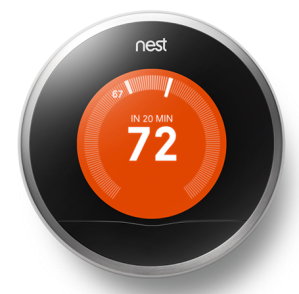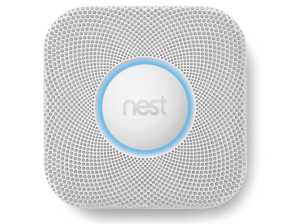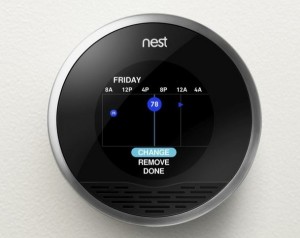 I love my slick Apple-esque Nest thermostat. Equipped with wi-fi and software brains that allow it to be controlled from anywhere in the world using nearly any device, it’s an element of my home that never fails to put a smile on my face. Consider this: The Nest, by automating your heating and cooling, can save you its initial cost every year or so. That’s right. The $250 Nest pays for itself in roughly one to two years, depending on the size and nature of your home and your A/C habits. It then keeps racking up the savings, all while giving you a beautifully sculpted aluminum and glass, cloud controlled, um, thermostat that looks great hanging on your wall.
I love my slick Apple-esque Nest thermostat. Equipped with wi-fi and software brains that allow it to be controlled from anywhere in the world using nearly any device, it’s an element of my home that never fails to put a smile on my face. Consider this: The Nest, by automating your heating and cooling, can save you its initial cost every year or so. That’s right. The $250 Nest pays for itself in roughly one to two years, depending on the size and nature of your home and your A/C habits. It then keeps racking up the savings, all while giving you a beautifully sculpted aluminum and glass, cloud controlled, um, thermostat that looks great hanging on your wall.
Thus, it caught my attention when, in October 2013, Nest introduced a connected smoke alarm, the Protect. Having already had a second generation Nest thermostat for several months, I was excited about the prospect of filling my house with intelligent, networked smoke detectors. Especially when one of the notification alarms could be my smartphone or tablet. Of course, all technolust aside, these are critical devices within our homes that protect our loved ones, pets, and possessions from disaster. In fact, according to the National Fire Protection Association, nearly two-thirds of the deaths resulting from home fires are directly connected to non-functioning smoke alarms. Wow. That’s a sobering stat.
Unfortunately, the Protect has suffered from some basic functional shortcomings and marketing flaws. One of these has been partially fixed, the other hasn’t.
First, the Protect was too expensive at its introductory price of $130. This was mainly because most homes require multiple smoke alarms to properly protect them, especially two-story houses. To replace all four of my smoke detectors with the Protect would have cost me $520. Hey now! Half a grand is a damn bit more than $130. For most families, this becomes cost prohibitive—especially considering that the Protect doesn’t pay for itself in saved energy costs like the Nest thermostat. Add to this the fact that your current smoke detectors, if properly maintained, are getting the job done and achieving the same basic goal of protecting you and your family. It becomes easy to understand why many consumers—even those who purchased one or more Nest thermostats—declined the opportunity to put a collection of Nest Protect smoke alarms in their home. I was one of them.
 In the spring of 2014, after some software glitches that potentially affected safety were discovered in the Protect by Nest, it was briefly (and voluntarily) pulled from the market and tweaked. When reintroduced two month later, it was priced at a more reasonable $100. However, it would still cost the average family $400 to replace four smoke alarms with Protects. This is arguably too expensive. It’s as if Protect should have both an individual price intended for small apartments and living quarters requiring only a single unit (obviously the highest) and also two-pack, three-pack, and four-pack prices, where the cost per unit goes down considerably. I doubt many consumers would spend more than $150 or $200 to replace all of their existing smoke detectors with Protect models (and even that would be a hard sell for many homeowners).
In the spring of 2014, after some software glitches that potentially affected safety were discovered in the Protect by Nest, it was briefly (and voluntarily) pulled from the market and tweaked. When reintroduced two month later, it was priced at a more reasonable $100. However, it would still cost the average family $400 to replace four smoke alarms with Protects. This is arguably too expensive. It’s as if Protect should have both an individual price intended for small apartments and living quarters requiring only a single unit (obviously the highest) and also two-pack, three-pack, and four-pack prices, where the cost per unit goes down considerably. I doubt many consumers would spend more than $150 or $200 to replace all of their existing smoke detectors with Protect models (and even that would be a hard sell for many homeowners).
Now let’s explore the Protect’s functional shortcoming. Chiefly, this is the fact that, although the Nest thermostat and the Protect do talk to one another (and both talk to the cloud), the Protect lacks a thermometer. One would reasonably expect such simple functionality in a device at this price point (even given the reintroduction discount). The collective frustration of consumers and OCD-prone efficiency geeks is only compounded by the fact that the Protect and Nest thermostat are designed and manufactured by the same company (a typically leading edge and intelligent company, at that).
Nest has found many of its most evangelic customers among tree hugging tech geeks who have acted as early adopters and helped spread the gospel among friends, coworkers, and Twitter followers. Frustrating this important group by neglecting something as simple as a temperature sensor—especially when your only other product is a freaking thermostat—might seem trivial, but it’s a misstep of grand proportions. By lacking a hygrometer (humidity detection) and thermometer, the Protect seems incomplete. What made the original Nest thermostat an almost overnight success was the fact that it was simple and damn near perfect. A follow up of Protect’s sub-par functionality is akin to Jaws 2 or The Matrix Reloaded (i.e. not nearly as good as the original).
Nest missed the opportunity to provide its thermostat, via data received from its smoke detector, with a more intelligent and accurate average temperature for your home (especially considering that a large percentage of Protect owners would also own the Nest thermostat). Because I have smoke detectors on three levels (basement, first floor, and upstairs), I would love my Nest thermostat to be getting temperature and humidity readings from around my house. Versus its current Neanderthal method: The happenstance location of the Nest itself. The larger and more nuanced the layout of the home, the less accurate this single point of detection becomes. The unit’s dashboard controls, available via the mobile app or website, could easily allow owners to disable the temperature readings from a particular Protect unit, such as one in an attic or basement. This would appease owners who, logically, might not want a particular Protect unit to influence the household average and possibly increase heating or cooling costs. Then again, the units could probably determine this on their own via their motion detectors.
 Yes, I know, Nest (like Honeywell and other competitors) must deal with probably thousands of government regulations and perform hundreds of hours of compliance testing and possible redesigns. This makes getting a product to market with the feature set desired by both Nest and its customers, at a price that makes everyone smile, about as challenging as you might imagine.
Yes, I know, Nest (like Honeywell and other competitors) must deal with probably thousands of government regulations and perform hundreds of hours of compliance testing and possible redesigns. This makes getting a product to market with the feature set desired by both Nest and its customers, at a price that makes everyone smile, about as challenging as you might imagine.
In its defense (and like many less intelligent, old school competing devices), the Protect is also a carbon monoxide detector. Slick, leading-edge features include voice and gesture controls. Personally, I love the classy touch of using the color-changing status ring LED on the device to illuminate the path below, acting as a ceiling-mounted nightlight. Because it has a motion sensor, it can dim or shut off the light when nobody is around, saving energy or preserving batteries. Then, when someone appears near it, it will magically pop to life, it’s motion sensor leading the way.
Nest, acquired in the winter of 2014 by Google for $3.2 billion, I’m sure will continue to design and sell cool internet-connected, cloud-manageable sensing and control devices that replace older, typically analog gadgets in our homes. Despite the name of this blog entry, I’m a big fan of Nest and Tony Fadell, it’s fearless leader and ex-Apple executive (responsible for the iPod when at Apple; you can see the circular design theme reiterated in the shape of the Nest thermostat).
The Nest and its future generations I’m sure will be attractive enough to sway the dollars out of my pocket. But until the Protect assumes massive discounts for three or four-packs (or some other way of making filling a middle class suburban home more affordable) and adds basic sensing capabilities like a thermometer, I personally won’t be interested. For $400, you can purchase some nice home theater equipment or a killer latest-generation game console.
Curt Robbins is author of the following books from Amazon Kindle:
- Home Theater for the Internet Age ($9.95)
- Understanding Personal Data Security ($4.99)
- Understanding Home Theater ($4.99)
- Understanding Cutting the Cord ($4.99)
- Understanding Digital Music ($4.99)
You can follow him on Twitter at @CurtRobbins, read his AV-related blog posts at rAVe Publications, and view his photos on Flickr.

Pingback: The Case for Home Theater Ethernet - rAVe [Publications]
Pingback: Home Automation: Increasingly Affordable - rAVe [Publications]